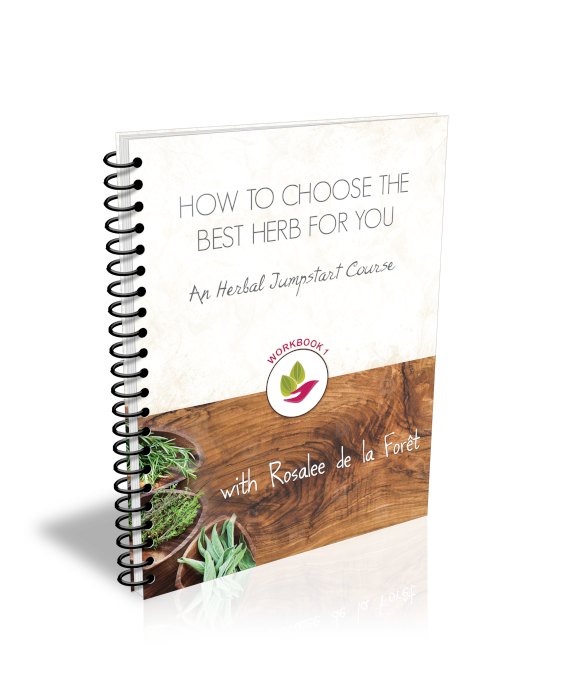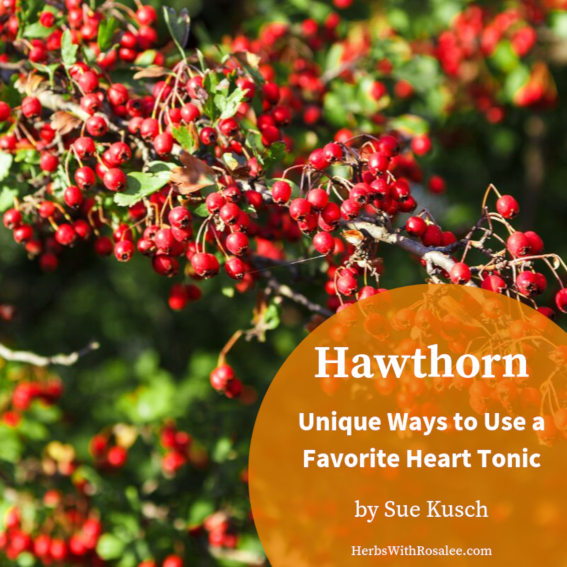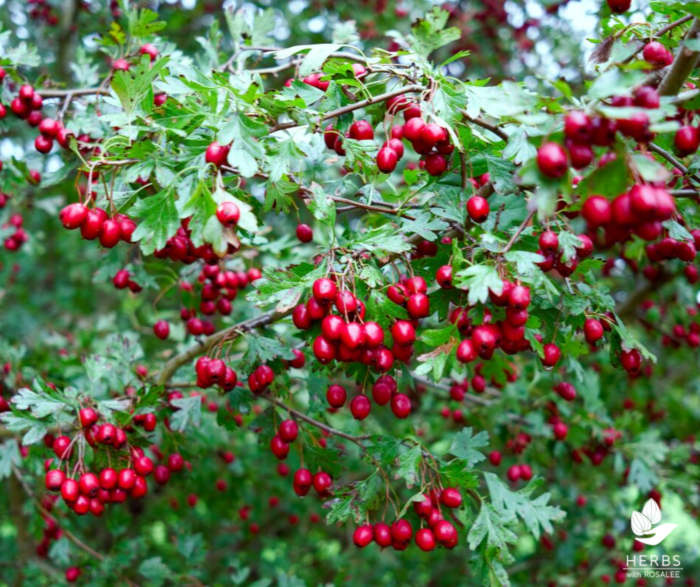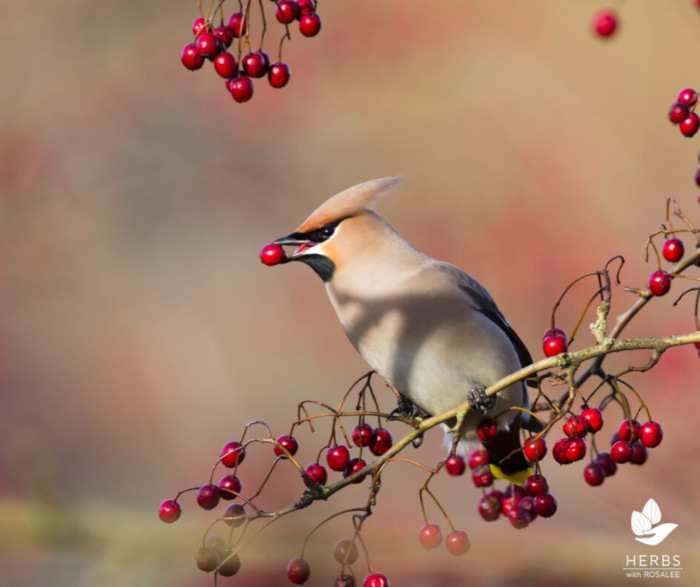Get weekly tips, recipes, and my Herbal Jumpstart e-course! Sign up for free today.

Hawthorn Uses
Share this! |
|
While visiting a beautiful rural property to discuss designing a couple of herb and flower gardens, the owner pointed at one of the boundaries of the property and said, “I want to get rid of those weedy shrubs over there.” The flowers had already bloomed (which can be an easy way to identify plants) so we headed over to the shrubs while she described the bright red berries that appeared each fall.
When I saw the leaves and the thorns I knew it was the European species of hawthorn (Crataegus monogyna), brought over to North America to serve as a source of fencing material and a hedgerow plant. Identification down to species can be challenging: there are almost 300 species worldwide and they love to hybridize but this species has made its way across North America. When I told the owner about the long history of hawthorn uses for the heart and how the berries could be used to make jam, tea, and even wine... she rolled her eyes and said, “Well, they need to stay then, don’t they?” The owner is a professional winemaker.
My other memorable story about hawthorn did not turn out as well. On a hot August afternoon, I joined a friend to pick the ripened black haws of our native Black Hawthorn (Crataegus douglasii) on her property. As we began, both of us disturbed an apparently large and not-visible-to-us gathering of yellow jackets who were also enjoying the ripened fruit. We were both stung immediately and the yellow jackets were buzzing us intensely. Taken by surprise and in panic mode, I bent down to grab my basket and run when a yellow jacket flew into my face. Trying to swipe it away, I lost my balance and fell into the large thorny hawthorn. Ignoring the pain, we ran down the road as fast as we could. We each are mildly allergic to yellow jackets and our arms were quickly swelling and throbbing. My fall into the shrub garnered a few scratches from the thorns. For all of that pain and trouble we each had a handful of hawthorn berries.
Around here, yellow jackets always rule.
Hawthorn Uses for the Heart
There is a long history of hawthorn uses as a food source among indigenous people in North America, and for centuries Europeans considered the hawthorn herb as one that maintained the health of the heart, helped with digestion and, during the Middle Ages, was used for sore throats, insomnia, and as a diuretic.
Modern research supports regular hawthorn uses as an herb that relaxes and repairs vascular walls, reduces blood pressure, positively affects cholesterol, relieves shortness of breath and fatigue and, specifically, assists people who live with mild levels of congestive heart failure. (Note: Always work with a health practitioner when considering the use of herbs to help with a diagnosed condition, and people taking pharmaceutical drugs should always check with their doctor or pharmacists for possible drug-herb interactions.)

Choose the Best Herb for You!
The secret to using herbs successfully begins with knowing who YOU are.
Get started by taking my free Herbal Jumpstart e-course
By signing up for my free course you’ll also be joining my weekly newsletter where I send my best tips and herbal recipes. I never sell your information and you can easily unsubscribe at any time.
Hawthorn Uses as a Tonic Herb
Herbalists consider hawthorn a tonic herb - one that supports the foundation of our health and can be safely taken each day to support our overall wellness by nourishing our body’s systems.
Like many people, when I first started exploring herbs I thought of them as either culinary seasonings or medicinal remedies. As I began to study individual herbs, I discovered that some herbs can be taken as daily or weekly tonics in the form of tea, tincture or capsules. It seems so obvious now but at the time it was a new way of thinking about how I could use herbs on a daily basis.
Since then, I have become a bit obsessed with thinking up ways that I can add tonic herbs to my everyday recipes because there is only so much tea I can drink in a day!
Adding powdered herbs to recipes is an easy way to add tonifying herbs to your daily foods. I powder some of the herbs I grow but I purchase powdered berries and roots from Mountain Rose Herbs. I do recommend buying small amounts with a plan to use them within three months, as powdered herbs lose their medicinal qualities faster than whole herbs. Here are a few ideas for incorporating the slightly tart and sweet tasting powdered hawthorn berries into your everyday recipes:
- Add ½ cup hawthorn berry powder as a total or partial replacement for sugar in quick breads like zucchini or pumpkin or your favorite cookie or cake recipe.
- Add a tablespoon to smoothies, shakes, and yogurt.
- Add several tablespoons to honey and ghee.
- Use Rosemary Gladstar’s recipe for Zoom balls as an inspiration to create a heart-healthy version.
- Make herbal truffles using hawthorn powder as one of the herbs. (Many recipes online)
Traditionally, whole hawthorn berries were utilized by Europeans to make jam, jelly, chutneys, pie fillings, wine, and ketchup. Last year, I had access to an abundance of fresh berries and made hawthorn ketchup for the first time. It was the perfect excuse to eat more than my share of french fries last fall!
The smelly/fragrant (you decide) hawthorn flowers also provide medicinal benefits for the heart and were traditionally used in making a spring cordial. The berries can also be used for cordial-making; cordials are delightful herbal liqueurs that look wonderful in antique cordial glassware and are perfect for sipping on a cold winter’s night.
For the tea drinkers, the berries, leaves, flowers and twigs can all be used to make tea and nourishing infusions.
Hawthorn Uses as a Syrup
One of the easiest ways to incorporate the heart-healthy hawthorn into your daily life is through a simple syrup. Syrups can be used to flavor water, smoothies, drizzled over yogurt, added to salad dressings and stir-fry sauces, and used as part of the sweetener in baking recipes. They are tasty enough to take by the tablespoon and are safe for all ages.
Directions:
- Combine 1 cup fresh or ½ cup dried hawthorn berries with 3 cups of water in a saucepot.
- Simmer for 30 minutes. Remove from heat, and cool.
- Mash berries with a potato masher, then simmer again for 30 minutes.
- Strain and return decoction to the pot.
- Add 1 cup of honey and stir until fully integrated.
- For additional benefit, blend a ¼ cup of hawthorn extract into the syrup.
- Store in the refrigerator for up to 3 weeks. Both the honey and tincture will help with preservation.
- Take 1-2 tablespoons of syrup daily.
Hawthorn Uses: Creative Drinks
I have become enamored with shrubs for the last few years, incorporating a variety of fruits and herbs for both flavor and health benefits. A shrub is a historical beverage that includes fruit infused in vinegar and then sweetened, usually with sugar but I often use honey. I make a half-gallon about once every six weeks and have a glass or two on most days. Though there is sugar or honey added, I can control the amount and now prefer the stronger tastes of vinegar to the sweet taste of sugar.
Shrubs are easy to make, nutritious, multifunctional, and embrace the creative drink maker in us. Berries and cherries are ideal but I have found many recipes that use apricots, peaches, pears, plums, nectarines, rhubarb, cranberries, apples, and even tomatoes and cucumbers. Herbs and spices can be added for flavor, additional nutrients, and medicinal benefits.
In the following seasonal recipe, I used a variety of cultivated and wild fruits and herbs that offer flavor and support for my cardiovascular and immune system.
Hawthorn Uses: Autumn Berry Shrub
Add to ½ gallon canning jar:
- 2 cups fresh or frozen strawberries, raspberries or blueberries (or a combination)
- 1 cup dried hawthorn berries
- ½ cup dried rose hips
- ½ cup dried elderberries
- ¼ cup hibiscus flowers
- 1 tablespoon allspice berries
Fill with a vinegar of your choice, ensuring that all of the fruit is covered:
- Organic raw apple cider vinegar brings a host of nutrients, minerals, vitamins, essential acids and enzymes to a shrub
- Balsamic Vinegar - rich, thick, sweet and ideal for berry shrubs
- White and red wine vinegar allow the fruit flavors to dominate.
Never use distilled white vinegar... except to clean the house.
Directions:
Stir and cover with a plastic lid. Store in a cool cupboard or the refrigerator for 7-10 days. Go in and stir or shake each day.
Strain the fruit & herbs out of the vinegar; a potato ricer is ideal for getting every last drop of goodness.
Add 2 - 4 cups of sugar to the infused vinegar: white, brown, or turbinado. Or add 1-3 cups of honey. Store in the refrigerator for one week, stirring each day to dissolve the sugar.
Pour into glass bottles and store in the refrigerator for up to a year.
To enjoy: Add 1-2 tablespoons to 8-10 ounces of water or carbonated water. I often squirt some bitters blend on top.
Shrubs can also be used to make salad dressings, as a base for marinades or in stir fry sauces.

Sue Kusch, a former community college instructor and academic advisor, incorporates her experiential wisdom, expertise and science-based research garnered from her three decades of growing vegetables, fruit and herbs into her educational writing about plants and how people use them. In addition to her BA in Social Sciences and Masters in Education, she completed the Master Gardener training in 2011 and two permaculture courses in 2001 and 2014. She has studied medicinal and nutritional uses of herbs, including studies at Herbmentor and East West School of Planetary Herbology, since 1997. An avid reader, lover of historical and folkloric information, and a promising storyteller, Sue writes about the intersection of plants and people.


